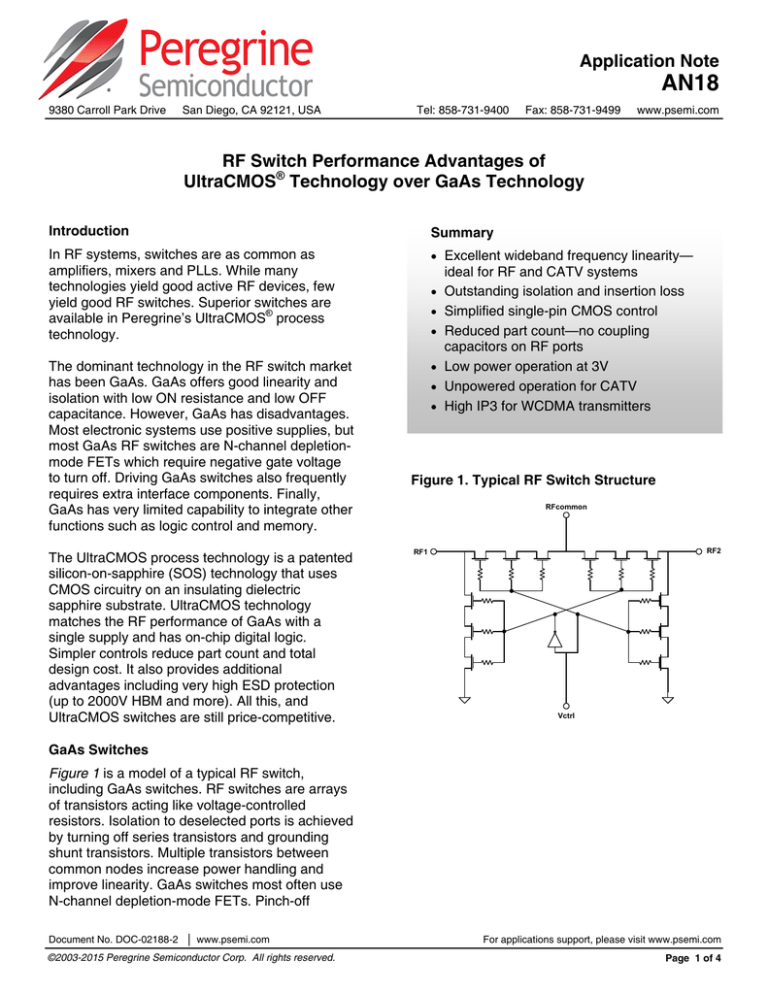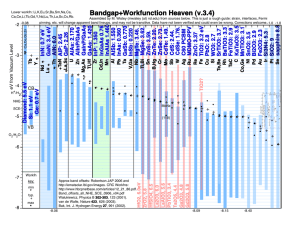
Application Note
AN18
9380 Carroll Park Drive
San Diego, CA 92121, USA
Tel: 858-731-9400
Fax: 858-731-9499
www.psemi.com
RF Switch Performance Advantages of
UltraCMOS® Technology over GaAs Technology
Introduction
Summary
In RF systems, switches are as common as
amplifiers, mixers and PLLs. While many
technologies yield good active RF devices, few
yield good RF switches. Superior switches are
available in Peregrine’s UltraCMOS® process
technology.
Excellent wideband frequency linearity—
The dominant technology in the RF switch market
has been GaAs. GaAs offers good linearity and
isolation with low ON resistance and low OFF
capacitance. However, GaAs has disadvantages.
Most electronic systems use positive supplies, but
most GaAs RF switches are N-channel depletionmode FETs which require negative gate voltage
to turn off. Driving GaAs switches also frequently
requires extra interface components. Finally,
GaAs has very limited capability to integrate other
functions such as logic control and memory.
The UltraCMOS process technology is a patented
silicon-on-sapphire (SOS) technology that uses
CMOS circuitry on an insulating dielectric
sapphire substrate. UltraCMOS technology
matches the RF performance of GaAs with a
single supply and has on-chip digital logic.
Simpler controls reduce part count and total
design cost. It also provides additional
advantages including very high ESD protection
(up to 2000V HBM and more). All this, and
UltraCMOS switches are still price-competitive.
ideal for RF and CATV systems
Outstanding isolation and insertion loss
Simplified single-pin CMOS control
Reduced part count—no coupling
capacitors on RF ports
Low power operation at 3V
Unpowered operation for CATV
High IP3 for WCDMA transmitters
Figure 1. Typical RF Switch Structure
RFcommon
RF2
RF1
Vctrl
GaAs Switches
Figure 1 is a model of a typical RF switch,
including GaAs switches. RF switches are arrays
of transistors acting like voltage-controlled
resistors. Isolation to deselected ports is achieved
by turning off series transistors and grounding
shunt transistors. Multiple transistors between
common nodes increase power handling and
improve linearity. GaAs switches most often use
N-channel depletion-mode FETs. Pinch-off
Document No. DOC-02188-2 │ www.psemi.com
©2003-2015 Peregrine Semiconductor Corp. All rights reserved.
For applications support, please visit www.psemi.com
Page 1 of 4
AN18
Application Note
typically occurs when gate voltage is –2V to –3V so
the gate is normally biased at 0V.
A problem with GaAs switches occurs in high power
operation. High RF power can modulate the gate
voltage, which varies channel resistance and
generates distortion products. Increasing DC
voltage on the gate can reduce this effect, but even
modest RF power may require gate voltage of 1V to
2V to turn the FET on and –3V and sometimes –5V
to –8V to turn the FET off. Performance for low
voltage systems is therefore often significantly
degraded.
Another problem is that GaAs switches require
coupling capacitors. While inexpensive, capacitors
are not free and inventory, board space and
placement may cost even more. External capacitors
constrain the minimum operating frequency.
Capacitors also have insertion loss, and while
usually minimal, in some systems even 0.1 dB is
significant.
Some manufacturers instead integrate coupling
capacitors in their GaAs switches. This eliminates
external components, but monolithic capacitors are
typically lower Q than discrete capacitors. Values
greater than 10 pF can increase die size and cost.
These switches are not suitable for low frequency or
wideband applications.
Consider the typical SPDT in Figure 2. Every RF
interface is capacitor-coupled. Now tie the ground
terminal positive and the negative terminal to
ground—the switch will operate with positive
voltage. By floating the device, positive bias pulls
the channels up to a voltage close to the control
voltage. This creates a negative bias when the
gate is grounded. Other tricks include pulling the
channels up to supply voltage externally or using
an internal resistive divider to pull the channels up
to one-half of supply.
Another way GaAs switch manufacturers try to get
around positive control logic problems is by mixing
processes. For example, in packaged multi-throw
switches they add a CMOS die. The auxiliary die
provides complementary and decoded control
lines and level-shifting, but both positive and
negative supplies are still required as well as a
larger package. The second die increases cost
and reduces reliability.
Integrated logic is yet another problem for GaAs
switches. N-channel FET GaAs switches with
integrated logic require resistors and a lot of
current. Complementary device GaAs switches
with integrated logic are unique, expensive, and
still draw current.
Positive logic control is another problem for GaAs
because implementing complementary logic in
GaAs consumes significant current. One way to get
around this is to float the die relative to DC ground.
Figure 2. Typical RF Switch Structure
CTRL
CTRL
For applications support, please visit www.psemi.com
Page 2 of 4
Document No. DOC-02188-2 │ UltraCMOS® RFIC Solutions
©2003-215 Peregrine Semiconductor Corp. All rights reserved.
AN18
Application Note
Peregrine UltraCMOS Technology
Peregrine RF switches are fabricated using the
patented UltraCMOS technology process. This
process provides the RF performance of GaAs,
including similar insertion loss and isolation, while
offering additional capabilities GaAs technology
lacks.
Figure 3 is a small signal model of an SPDT switch.
Like GaAs, UltraCMOS-based RF switches are
FETs that act as voltage-controlled resistors. ONseries resistance (RON) and the OFF-equivalent
capacitance (COFF) is similar to GaAs. In 0.5-micron
UltraCMOS technology the RON × COFF product is
as low as 800Ω –fF, and RON and COFF figures-ofmerit improve as process geometry shrinks.
Figure 3. Small-signal Model of SPDT RF Switch
RF Common
Package &
Bond Wires
Package &
Bond Wires
Off FET
On FET
RF1 (OFF)
Package &
Bond Wires
RF2 (ON)
On FET
Off FET
Package &
Bond Wires
Low power switches (P1dB up to +27 dBm) use
transistors with thresholds of 0.8 volts. Low-voltage
CMOS logic drive them directly. In higher power
switches (P1dB up to +30 dBm), a 3-volt control
span is insufficient for signal swing. Once again,
UltraCMOS technology has a solution because any
CMOS function is easily integrated.
Adding a negative voltage generator (NVG)
increases operating range of each FET from two
times threshold voltage to two times supply voltage.
This also permits use of high-performance 0 VTH
transistors. Although the NVG introduces a noise
spur, it is extremely low (about –127dBm), in part
due to the high isolation of the sapphire substrate.
Note: an integrated NVG is inconceivable in GaAs.
Document No. DOC-02188-2 │ www.psemi.com
©2003-2015 Peregrine Semiconductor Corp. All rights reserved.
Figure 4. UltraCMOS-based SPDT RF Switch
Functional Model
RFIN
RF+
RF-
CMOS
Logic
Control
+3V
-3V
-3 V Generator
3V
Figure 4 shows the block diagram of a high-power
UltraCMOS RF switch, including integrated NVG
and logic, providing true single-wire control.
Another tremendous advantage of UltraCMOS
technology is integrated control logic. A GaAs
SPDT typically requires two dedicated pins from
the controller. GaAs switches often also require
significant control currents and external buffering.
Peregrine’s switches always provide CMOScompatible control.
This simplified control is even more beneficial in
multi-throw switches. A GaAs SP6T requires 10
control pins. An UltraCMOS-based SP6T can be
implemented with three decoded input lines or
even a 3-pin serial interface. The results are fewer
microprocessor pins, fewer package pins,
elimination of support circuitry, and simpler PCB
routing.
Summary
A design with GaAs RF switches requires external
circuitry and costly and complex level conversion
for positive logic control. A design with Peregrine
Semiconductor’s RF switches is less costly and
complex because UltraCMOS-based switches
require no coupling capacitors, interface directly
with positive logic control, achieve high IP3 for 3V
systems, and integrate decoding, serial, and/or
parallel interfaces.
For applications support, please visit www.psemi.com
Page 3 of 4
AN18
Application Note
The information in this document is believed to be reliable. However, Peregrine assumes no liability for the use of this information. Use shall be entirely at the user’s own risk. No patent rights or licenses to any circuits
described in this datasheet are implied or granted to any third party.
Peregrine’s products are not designed or intended for use in devices or systems intended for surgical implant, or in other applications intended to support or sustain life, or in any application in which the failure of the
Peregrine product could create a situation in which personal injury or death might occur. Peregrine assumes no liability for damages, including consequential or incidental damages, arising out of the use of its products in
such applications.
The Peregrine name, logo, UltraCMOS and UTSi are registered trademarks and HaRP, MultiSwitch and DuNE are trademarks of Peregrine Semiconductor Corp. Peregrine products are protected under one or more of the
following U.S. Patents: http://patents.psemi.com.
For applications support, please visit www.psemi.com
Page 4 of 4
Document No. DOC-02188-2 │ UltraCMOS® RFIC Solutions
©2003-215 Peregrine Semiconductor Corp. All rights reserved.

